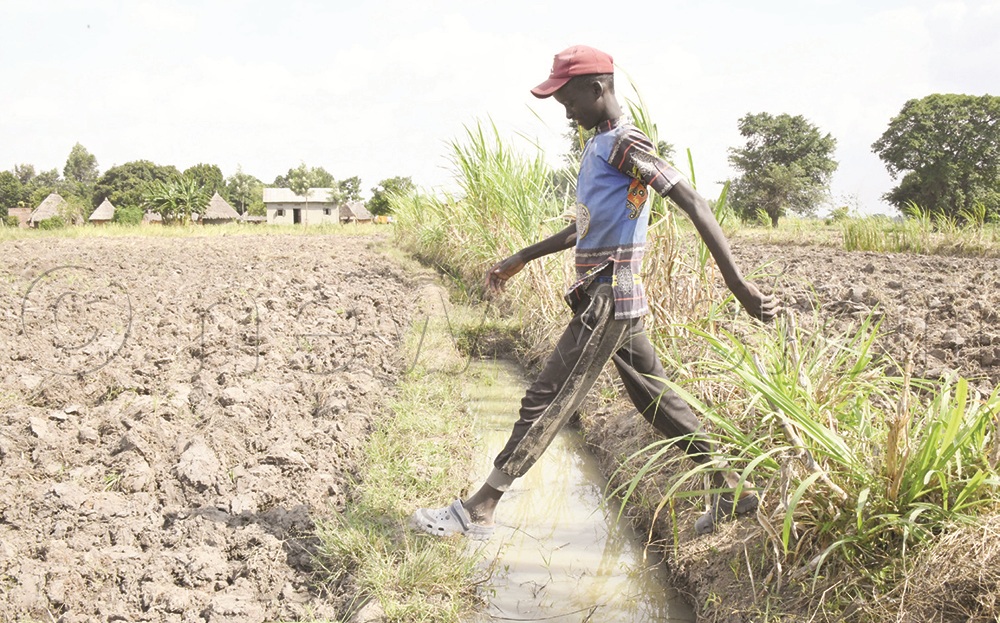Flood control trenches turning tide on farms in Eastern Uganda
Godfrey Okiror, the project officer, says trenches are designed to trap and slow floodwater.
Okiror (centre) explains how the trenches work. ( Photos by Mpalanyi Ssentongo)
________________
In Uganda’s flood-prone regions, seasonal rains often bring devastation — washing away crops, pastures, homes and cutting off feeder roads.
However, a simple and cost-effective solution is helping farmers reclaim their land and livelihoods: flood control trenches.
In Ajesa village, Kabarwa parish, Bukedea district, Peter Ogetei, a farmer, had nearly given up on his 15-acre farm.
“The rain often washed away everything. Given that the land slopes downwards towards the swamp, it would flood during rainy seasons,” he says.
Then came a turning point. Officials from the Ministry of Water and Environment, in partnership with the World Wildlife Fund for Nature, approached Ogetei to use his land as a demonstration site in the Integrated Water Management Development Project.
The goal was to teach farmers in Teso and Elgon sub-regions in eastern Uganda how to manage floods and landslides using trenches and vetiver grass.
How it works
Godfrey Okiror, the project officer, says trenches are designed to trap and slow floodwater. Each trench should be 2.5m wide, 1.5m deep, and 40m long, spaced 5m apart on land over 15 acres.
“Floodwater is first trapped in the trenches. When one fills, the next traps the overflow. This reduces the speed and volume of water, preventing flooding,” Okiror explains.

Flood control trenches used on a farm in Bukedea district. They help manage fl ooding. Trench walls are stabilised using Napier grass, which doubles as cow feed.
To further reduce surface runoff and erosion, water percolation infiltration pits are dug upstream in flood-prone spots. These should be 2.26m in diameter and one metre deep, or two square metres by one metre deep.
The soil bunds are stabilised with Napier grass, which also serves as cattle feed.
Another farmer, only identified as Otude, who adopted the method, says: “I’ve prepared five acres for rice because now the water is controlled. The trapped water is clean — we even use it for cooking and drinking.
Benefits beyond
Napier grass planted in trenches not only stabilises soil, but also boosts milk production by providing feed for cattle.
“This water and grass have saved me from walking cows long distances in search of pasture,” Otude adds.
It also protects livestock from disease by reducing contact with contaminated watering holes.
In Sironko and Bulambuli districts, the project introduced vetiver grass to combat landslides. Known for its deep, fibrous roots, vetiver acts like an underground retaining wall, according to the Vetiver Network of the West Indies.
Its roots grow vertically, binding soil and absorbing water, reducing the risk of slope failure.
Restoring water bodies
To further mitigate flooding, the project demarcated and restored riverbanks, offering alternative income sources to communities previously farming wetlands.
These include fish farming, beekeeping, nursery tree growing and agroforestry.
In Kalengo wetland, Bukedea district, 30 women who once grew rice and vegetables have embraced fsh farming.
With support from the project, they established ponds stocked with fingerlings and received feed for the first harvest.
Joyce Akia, a community facilitator and group member, says: “We have 1,000 fish in the pond. We plan to sell each at sh2,500 to sh3,000. Part of the money will restock the pond, and the rest will be shared among members.”
Sustainable future
Through simple, replicable interventions like trenches, vetiver grass and alternative livelihoods, farmers in flood-prone areas are reclaiming their land and building resilience.
As Ogetei’s story shows, what once seemed like a lost cause can become a model for sustainable farming and community empowerment.